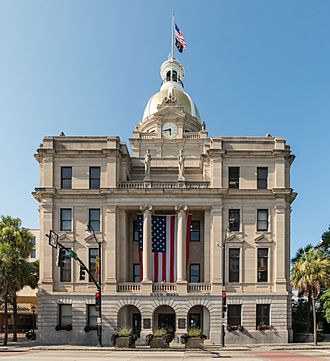Savannah City Hall facts for kids
Quick facts for kids Savannah City Hall |
|
|---|---|

Savannah City Hall (2016)
|
|
| General information | |
| Architectural style | Renaissance Revival |
| Address | 2 Bay Street Savannah, Georgia, United States |
| Coordinates | 32°4′52″N 81°5′28″W / 32.08111°N 81.09111°W |
| Groundbreaking | August 11, 1904 |
| Completed | 1905 |
| Opened | January 2, 1906 |
| Cost | $250,000 |
| Height | 139.99 feet (42.67 m) |
| Technical details | |
| Floor count | 6 |
| Lifts/elevators | 1 |
| Design and construction | |
| Architect | Hyman Witcover |
| References | |
| Savannah City Hall at Emporis | |
Savannah City Hall is a very important building in Savannah, Georgia. It's where the city's government works. Think of it as the main office for the people who run the city! A famous architect named Hyman Witcover designed it. The building was finished in 1905 and opened in 1906. It's a key part of the historic area of Savannah.
Contents
A Look Back: The History of City Hall
What Was Here Before?
Before the current City Hall was built, there was another building called the City Exchange. This older building was built way back in 1799. It stood for a long time, but it was taken down in 1904 to make space for the new City Hall.
Building a New Home for the City
The first stone for the new City Hall was placed on August 11, 1904. This was a big event with a special ceremony. The person who designed this amazing building was Hyman Witcover. He was a well-known architect who designed many other buildings in the area. The Savannah Contracting Company was in charge of building it.
The construction happened when Herman Myers was the Mayor of Savannah. Mayor Myers was known for starting many big building projects for the city. He believed the new City Hall would show how modern and energetic Savannah was becoming. He called it "a monument to the progressive spirit." This building was the very first one built just to be the city's main government office.
How Much Did It Cost?
Building the Savannah City Hall cost more than $250,000. That was a lot of money back then! The building was finished in 1905. It stands right across the street from another important building, the United States Customhouse.
The Building's Style and Look
Savannah City Hall is built in a style called Renaissance Revival architecture. This style looks back to the grand buildings of the European Renaissance. The outside of the building is made from strong materials like limestone and granite. On top, it has a shiny copper dome.
When the building was first planned, there were ideas for four statues of chariots on each corner of the roof. But there wasn't enough money to add them.
Opening Day and Special Features
The City Hall officially opened its doors on January 2, 1906. Many years later, in 1987, the copper dome got a special makeover. It was covered in gold leaf, which makes it look golden and very grand!
In 2014, the Georgia Historical Society worked with the mayor and other city leaders. They put up a Georgia historical marker at City Hall. This marker tells visitors about the building's history and importance.

